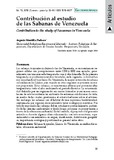| dc.rights.license | http://creativecommons.org/licenses/by-nc-sa/3.0/ve/ | |
| dc.contributor.author | Montilla Pacheco, Argenis | |
| dc.date.accessioned | 2014-09-18T14:53:06Z | |
| dc.date.available | 2014-09-18T14:53:06Z | |
| dc.date.issued | 2014-09-18T14:53:06Z | |
| dc.identifier.issn | 1316-6077 | |
| dc.identifier.uri | http://www.saber.ula.ve/handle/123456789/38983 | |
| dc.description.abstract | Las sabanas tropicales incluyendo las de Venezuela, se encuentran en regiones
cálidas con precipitaciones entre 1200 y 1800 mm anuales, generalmente
con una marcada temporada seca y otra húmeda. En la primera
temporada se producen incendios forestales, en la segunda, se desbordan
ríos inundando el bajo llano. En Venezuela, la mayor extensión de sabana
se localiza en los Llanos, aún cuando en otras regiones se presenta en menor
proporción. Estas sabanas, se caracterizan además por presentar altas
temperaturas todo el año, incluyendo el período lluvioso. La estacionalidad
definida por un régimen de seis meses húmedos y seis meses secos,
hacen de este ecosistema un ambiente de extremas condiciones de vida,
en medio de las cuales, predomina el estrato herbáceo sobre el arbóreo.
Sin embargo, las sabanas son el hábitat de una riquísima biodiversidad,
conformada por especies de incalculable valor ecológico y científico. Por
todo lo expresado, las sabanas deben estudiarse profundamente, partiendo
de las ciencias ambientales y desde luego, procurar su preservación a
través de la educación ambiental. En tal sentido, el propósito del presente
artículo es discutir algunas ideas relacionadas con este ecosistema, especialmente
lo concerniente a su origen, clasificación, distribución geográfica,
importancia ecológica y problemática general entre otros. | es_VE |
| dc.language.iso | es | es_VE |
| dc.rights | info:eu-repo/semantics/openAccess | |
| dc.subject | Sabanas tropicales | es_VE |
| dc.subject | Llanos de Venezuela | es_VE |
| dc.subject | Incendios forestales | es_VE |
| dc.subject | Educación ambiental | es_VE |
| dc.title | Contribución al estudio de las Sabanas de Venezuela | es_VE |
| dc.title.alternative | Contribution to the study of savannas in Venezuela | es_VE |
| dc.type | info:eu-repo/semantics/article | |
| dc.description.abstract1 | Including the tropical savannas of Venezuela, they are in hot regions with
rainfall between 1200 and 1800 mm per year, usually with a pronounced
dry and wet season. Fires of forest occur in the first season. In the
second, overflowing rivers inundate the low plain. In Venezuela, the largest
expanse of savannas is located in plains, although in other regions is
presented in smaller proportion. These flat areas, are also characterized
by high temperatures present all year round, including the rainy season.
Seasonality defined by a system of six months wet and six months dry,
make this ecosystem an environment of extreme living conditions, in the
midst of which dominates the herbaceous layer rather than trees. However,
the savannas are home to a rich biodiversity; include species with an
incalculable ecological and scientific value. For all the above, the savannas
should be studied deeply, starting from the environmental sciences and
of course, ensure their preservation through environmental education.
In this sense, the purpose of this article is to discuss some ideas related
to this ecosystem, especially concerning its origin, classification, geographical
distribution, ecological importance and general problems, among
others. | es_VE |
| dc.description.colacion | 35-48 | es_VE |
| dc.description.email | argenismontilla@hotmail.com | es_VE |
| dc.description.frecuencia | semestral | |
| dc.identifier.depositolegal | 199-602TA950 | |
| dc.subject.facultad | Núcleo Táchira (NUTULA) | es_VE |
| dc.subject.keywords | Tropical savannas | es_VE |
| dc.subject.keywords | Llanos of Venezuela | es_VE |
| dc.subject.keywords | Wildfires | es_VE |
| dc.subject.keywords | Environmental education | es_VE |
| dc.subject.publicacionelectronica | Revista Geoenseñanza | |
| dc.subject.seccion | Revista Geoenseñanza: Artículos | es_VE |
| dc.subject.thematiccategory | Geografía | es_VE |
| dc.subject.tipo | Revistas | es_VE |
| dc.type.media | Texto | es_VE |


